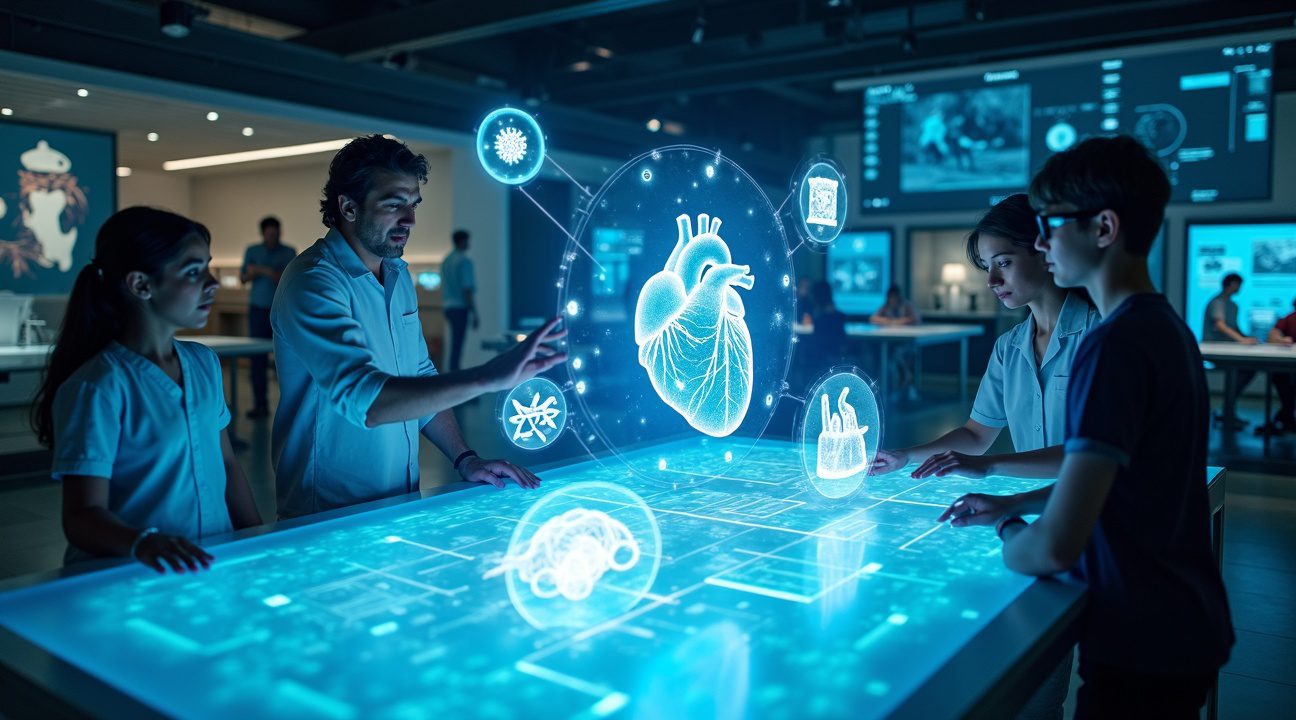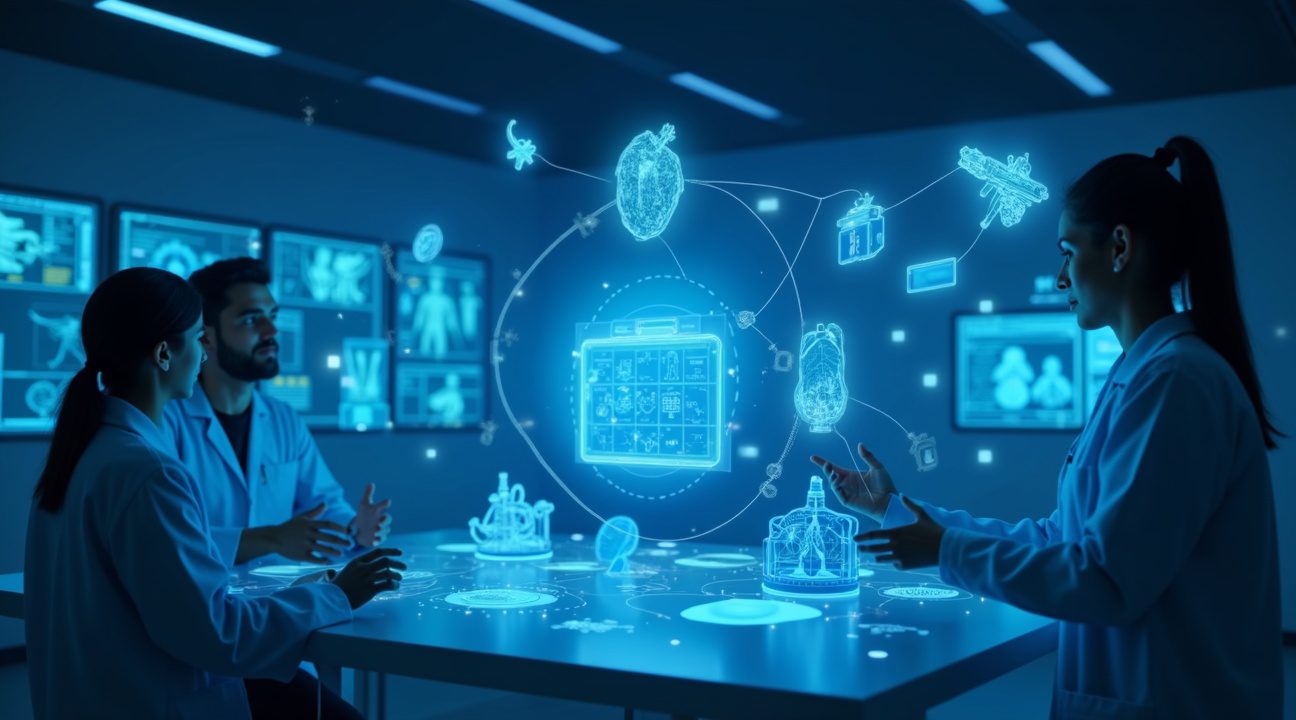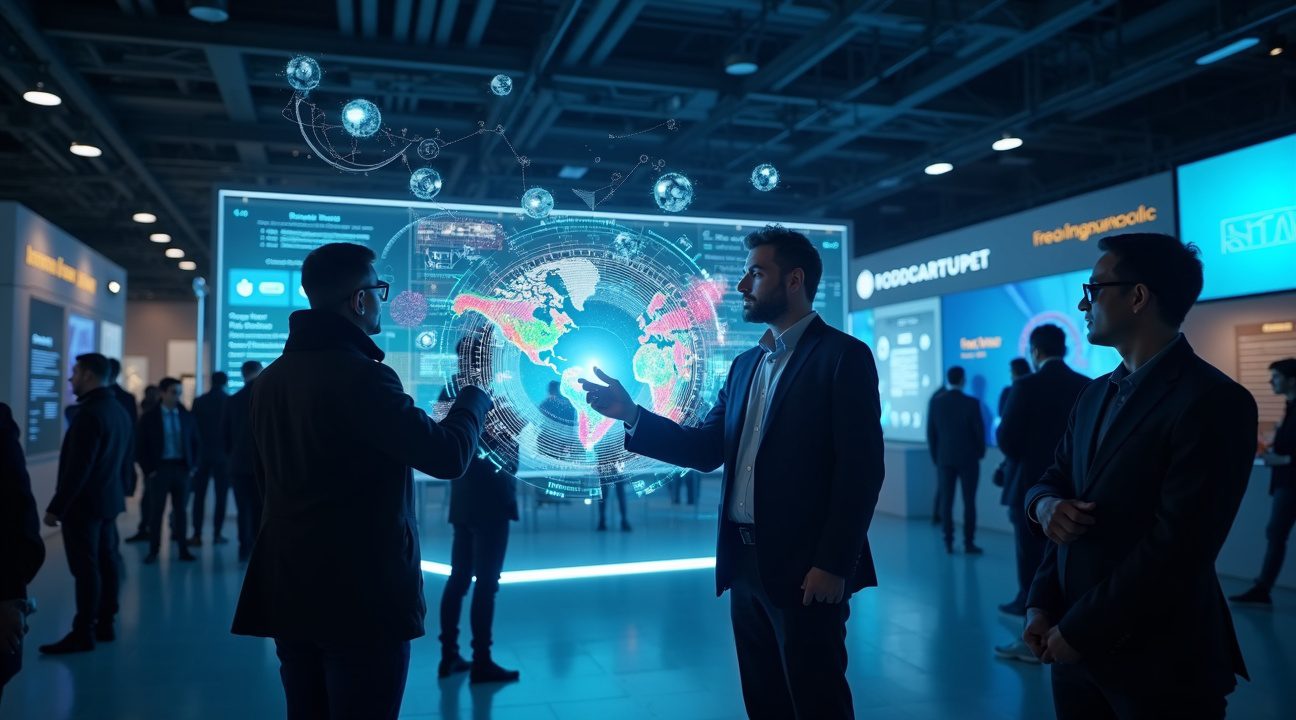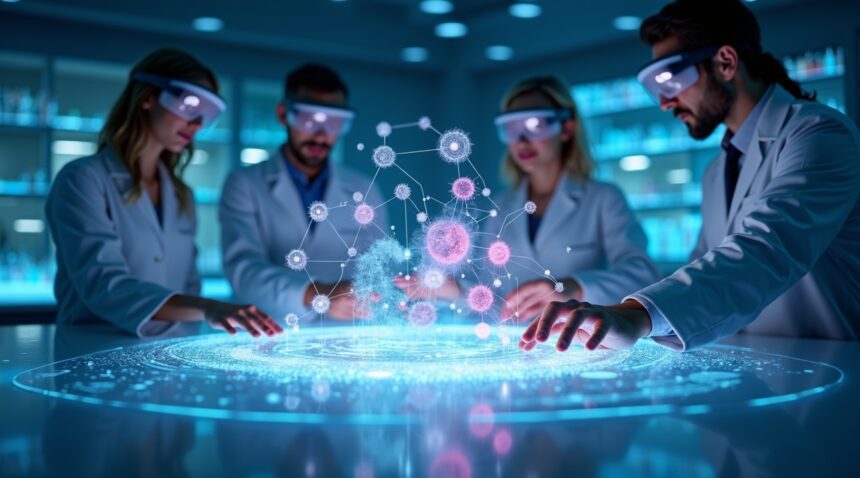Scientists have successfully developed touchable hologram technology using elastic diffuser membranes that allow users to physically interact with three-dimensional projected images.
Key Takeaways
- Elastic diffuser technology replaces rigid components with flexible membranes, allowing users to safely press, squeeze, and manipulate holographic displays without equipment damage or injury
- Real-time software adaptation continuously monitors membrane deformation and instantly adjusts projected images to maintain visual integrity and spatial accuracy during interaction
- Multi-user collaboration enables simultaneous interaction by multiple people with the same holographic display, making it valuable for educational, medical, and industrial applications
- Industry transformation potential spans manufacturing (3D model manipulation), education (hands-on learning), medicine (surgical training), and remote collaboration through tactile feedback
- Commercial investment momentum includes significant funding like Swave Photonics’ €27 million Series A round, though challenges remain in manufacturing scalability and cost reduction for mainstream adoption
A New Era of Human-Digital Interaction
This technology fundamentally changes how humans interact with digital content. Engineers have solved the long-standing problem of making holograms physically responsive while preserving visual quality. The elastic membrane system creates a bridge between digital and physical experiences that traditional displays cannot match.
The breakthrough addresses decades of limitations in holographic technology. Previous systems required users to maintain strict distances from projections to avoid damaging equipment. These new elastic diffusers eliminate such restrictions entirely. Users can now touch, press, and manipulate holographic objects as if they were physical items.
Applications Across Industries
Manufacturing and Engineering
Manufacturing applications stand to benefit significantly from this advancement. Design teams can now physically examine 3D models during development phases. Engineers can test spatial relationships and component interactions through direct manipulation rather than abstract observation. This hands-on approach accelerates design iterations and reduces costly prototyping phases.
Healthcare and Training
Medical training scenarios gain unprecedented realism through touchable holographic anatomy. Students can explore internal structures by physically manipulating organs and systems. Surgical residents practice procedures on holographic patients that respond to pressure and movement. This tactile feedback develops muscle memory impossible to achieve through traditional visual-only training methods.
Education
Educational institutions can transform abstract concepts into tangible experiences. Physics students manipulate molecular structures with their hands. History classes explore architectural models through direct interaction. Mathematics becomes spatial and tactile rather than purely theoretical.
Remote Collaboration
Remote collaboration capabilities multiply exponentially with touchable holograms. Teams separated by continents can share physical manipulation of the same holographic objects. Product development cycles compress when designers worldwide can simultaneously touch and modify prototypes in real-time.
How the Technology Works
The elastic diffuser membrane technology operates through sophisticated sensor networks. These systems detect even minor deformations in the membrane surface. Advanced algorithms process this data instantaneously, adjusting holographic projections to match physical interactions. This real-time responsiveness creates seamless integration between touch and vision.
Commercial Interest and Investment
Investment patterns show strong confidence in touchable hologram technology. Swave Photonics’ €27 million Series A funding demonstrates serious commercial interest. Multiple companies are racing to bring products to market. Competition drives rapid technological advancement and cost reduction efforts.
Scalability and Manufacturing Challenges
Manufacturing scalability remains the primary challenge facing widespread adoption. Current production methods suit laboratory environments but struggle with mass production requirements. Companies must develop streamlined manufacturing processes to achieve consumer-friendly pricing. Material science advances continue improving membrane durability and responsiveness characteristics.
Cost barriers currently limit adoption to specialized applications. Research institutions and high-value industries justify current pricing levels. Consumer applications await significant cost reductions. Market analysts predict mainstream adoption within five to seven years as production scales increase.
Quality and Reliability Standards
Quality control standards for touchable holograms exceed traditional display requirements. Manufacturers must ensure consistent membrane performance across temperature ranges. Holographic projection systems require precise calibration for optimal touch responsiveness. Testing protocols verify durability under repeated physical interaction.
Future Developments and Innovations
Future development focuses on enhancing tactile feedback sophistication. Researchers explore temperature simulation and texture variation capabilities. Advanced membrane materials promise increased sensitivity and longer operational lifespans. Integration with haptic feedback systems could create even more realistic physical sensations.
New Market Opportunities
The technology opens entirely new market categories. Entertainment industries can create immersive experiences impossible with traditional media. Retail applications allow customers to examine holographic products before purchase. Architectural firms can provide clients with touchable building models during design phases.
Professional Training Beyond Medicine
Professional training applications extend beyond medicine and manufacturing. Pilots can practice instrument manipulation on holographic cockpits. Mechanics learn repair procedures through hands-on holographic engine interaction. Emergency responders train on realistic holographic scenarios without safety risks.
Deployment and Market Strategies
Commercial deployment strategies vary significantly across industries. Some companies focus on high-value specialized applications first. Others pursue broader consumer markets despite current cost challenges. Success depends on matching technology capabilities with appropriate market segments.
Reshaping the Future
This touchable hologram breakthrough represents more than incremental improvement. Scientists have fundamentally changed the relationship between humans and digital information. Physical interaction with virtual objects creates possibilities that seemed purely fictional just years ago. The technology promises to reshape how people work, learn, and collaborate across virtually every industry.
How the Elastic Diffuser Technology Makes Physical Interaction Possible
The revolutionary breakthrough in touchable holograms centers on a specialized volumetric display that incorporates an elastic diffuser membrane. This flexible material replaces the rigid components found in traditional holographic systems, creating a safe environment where users can physically interact with three-dimensional images without fear of equipment damage or personal injury.
The Flexible Display Foundation
Previous volumetric displays relied on hard, inflexible surfaces that severely limited tactile engagement opportunities. Users couldn’t touch or manipulate the projected images because contact risked damaging expensive equipment or causing harm through sharp edges and rigid components. The new elastic diffuser changes this dynamic completely by introducing a soft, pliable material that responds naturally to human touch.
Researchers extensively tested various elastic materials to identify the optimal combination of optical transparency and mechanical flexibility. The selected membrane maintains exceptional image clarity while allowing users to press, squeeze, and manipulate the surface safely. This material innovation represents a fundamental shift in how people can engage with holographic technology.
Advanced Software Integration
The system’s sophisticated software algorithms continuously monitor and respond to membrane deformation in real-time. When users touch or press the elastic surface, the rendering engine instantly adjusts the projected image to maintain visual integrity and spatial accuracy. This immediate adaptation prevents distortion and ensures that the holographic display remains crisp and clearly defined throughout interaction.
The software’s responsiveness enables natural gestures and movements that feel intuitive to users. People can reach out and touch virtual objects as they would physical items, creating an immersive experience that bridges the gap between digital content and tangible reality. This technology opens new possibilities for applications in education, where students might examine molecular structures by touch, or in medical training, where practitioners could feel anatomical features.
Multiple users can simultaneously interact with the same holographic display, making it particularly valuable for collaborative environments. Museums can offer interactive exhibits where families explore historical artifacts together, while industrial teams can examine and manipulate 3D product prototypes during planning sessions. The elastic diffuser supports this shared engagement without compromising image quality or user safety.
This smart glasses technology complements existing augmented reality developments, creating more comprehensive immersive experiences. The combination of tactile feedback with visual projection represents a significant advancement in human-computer interaction, promising applications across entertainment, education, healthcare, and professional design fields.

Understanding the Science Behind Volumetric Displays vs True Holograms
Many people confuse touchable holographic technology with true holography, but these innovations actually rely on volumetric displays rather than traditional holographic principles. Volumetric displays generate three-dimensional graphics that viewers can observe from multiple angles in real space, creating an immersive experience that differs significantly from flat projections or conventional screens.
The distinction becomes clear when examining how these systems function. True holograms capture and reconstruct light patterns to create optical illusions of three-dimensional objects. Volumetric displays, however, physically generate light points throughout a defined volume of space, allowing users to walk around and view objects from different perspectives naturally.
Major Technological Milestones
Several breakthrough developments have paved the way for today’s touchable holographic systems:
- Asia’s first interactive holographic talks launched in Beijing during 2017, utilizing low-latency streaming technology combined with 2D video projection to connect remote speakers with live audiences
- The 2025 touchable device represents a significant leap forward by enabling direct physical interaction with three-dimensional holographic content
- Swave Photonics has advanced the field through development of specialized chipsets that produce high-resolution augmented reality experiences using nano-pixel technology
- Researchers at the University of St Andrews have created OLED-based holographic metasurfaces that promise more compact and efficient hologram generation for consumer applications
These innovations demonstrate how smart glasses technology continues evolving beyond simple visual overlays. Each advancement brings us closer to science fiction concepts becoming practical reality.
The nano-pixel approach developed by Swave Photonics allows for unprecedented resolution in compact form factors, while the OLED metasurfaces from St Andrews University address power efficiency concerns that have historically limited portable holographic devices. These parallel developments suggest that consumer-grade volumetric displays will soon become viable for everyday applications.
Modern volumetric systems create tangible interactions by combining precise light generation with haptic feedback mechanisms. This integration allows users to feel resistance, texture, and temperature variations when touching holographic objects. The technology builds upon earlier work in spatial audio and gesture recognition, creating comprehensive sensory experiences that extend beyond visual perception alone.
Current volumetric displays represent just the beginning of what’s possible when physical interaction meets three-dimensional light projection, setting the stage for revolutionary changes in how people interact with digital content.
Transforming Industries from Manufacturing to Medicine Through Tactile Holograms
Revolutionizing Manufacturing and Design Processes
Engineers can now directly manipulate 3D models with unprecedented precision, fundamentally changing how design and development work gets done. Real-time testing capabilities allow teams to identify flaws and optimize products before committing to expensive physical prototypes. Streamlined processes such as assembly and quality control benefit from immediate tactile feedback that helps workers understand spatial relationships and component interactions.
Digital twins—virtual replicas of physical assets—gain significant enhancement through tactile holographic interfaces. These advanced systems accelerate innovation cycles while dramatically reducing development costs. Manufacturing teams can feel component stress points, test assembly sequences, and validate designs through hands-on interaction with holographic representations.
Logistics operations see immediate benefits through virtual warehouse layouts and delivery route modeling. Teams can collaboratively adjust configurations, test efficiency improvements, and reduce planning errors through shared holographic workspaces. Just as flying car technology transforms transportation planning, tactile holograms reshape how supply chains operate.
Educational and Medical Applications
Educational institutions find remarkable value in touchable holographic displays that eliminate equipment barriers. Visitors and students approach displays and interact directly with content, whether they’re assembling engine parts, examining molecular structures, or exploring virtual galleries. This hands-on approach requires no specialized gear while delivering immersive learning experiences that surpass traditional methods.
Medical applications show tremendous promise for remote diagnostics and collaborative treatment planning. Surgeons can examine holographic patient anatomy, practice procedures, and consult with specialists across distances through shared tactile interfaces. Similar to how smart glasses technology enhances medical visualization, tactile holograms add crucial touch sensation to virtual medical environments.
The demonstrated ability to project interactive, low-latency, touchable holograms creates new possibilities for distributed teamwork and immersive telepresence. Remote collaboration gains physical dimension as team members share virtual workspaces where they can manipulate objects together. Engineering reviews, medical consultations, and educational sessions benefit from this enhanced interactivity that bridges geographical gaps while maintaining tactile communication essential for complex tasks.

Overcoming Technical Hurdles and Future Innovation Roadmap
The development of touchable holograms faces several significant challenges that researchers must address before these systems can reach mainstream applications. The proprietary composition of the elastic diffuser represents one of the most pressing concerns, as manufacturers haven’t yet disclosed the exact materials or processes required for creating these specialized components. This lack of transparency complicates efforts to refine the technology for mass production scenarios.
Production scalability poses another substantial barrier that engineers continue to tackle. Current prototypes work effectively in controlled laboratory environments, but maintaining the same level of performance while reducing costs for commercial applications requires innovative manufacturing approaches. The delicate balance between quality, durability, and affordability demands careful optimization across multiple variables.
Advanced Computing and Network Integration
Future developments in touchable hologram technology will likely benefit from several emerging technological trends:
- AI-powered spatial computing systems that can process user interactions and environmental changes in real-time, creating dynamic holographic responses
- Advanced haptic feedback mechanisms that simulate various textures, resistance levels, and surface properties for enhanced user experience
- Integration with smart glasses and augmented reality devices for seamless mixed-reality experiences
- Ultra-low latency networking capabilities that enable distributed applications across multiple locations
The anticipated rollout of 6G networks could revolutionize how these holographic systems operate in professional settings. Ultra-low latency interactions would make real-time distributed applications feasible, particularly in critical fields like remote surgery where precision and immediate response are essential. Surgeons could potentially manipulate holographic representations of organs or medical instruments with tactile feedback, while colleagues in different locations observe and collaborate on procedures.
Enhanced haptic technology represents another frontier that researchers actively pursue. Current systems provide basic touch sensations, but future iterations aim to simulate complex material properties. Users might feel the difference between silk and sandpaper textures, experience the resistance of pushing through various substances, or sense temperature variations across holographic surfaces.
The integration of AI-powered spatial computing opens possibilities for adaptive holographic environments that respond intelligently to user behavior and preferences. These systems could learn from interaction patterns, automatically adjusting display parameters for optimal user experience or predicting user intentions based on gesture patterns.
However, several factors continue to slow progress. The elastic diffuser technology requires additional refinement to improve longevity and consistency across different operating conditions. Temperature fluctuations, humidity changes, and extended usage periods can affect performance, necessitating more resilient materials and designs.
Manufacturing challenges extend beyond materials to include precision assembly requirements and quality control standards. Each holographic display system requires exact calibration and alignment of multiple optical components, making large-scale production complex and potentially expensive.
Much of the current research remains in pre-publication stages, awaiting peer review and validation through independent testing. This careful scientific approach ensures reliability but delays potential commercial applications. Researchers must demonstrate consistent results across various conditions and user scenarios before the technology gains widespread acceptance.
The liquid robotics field offers insights into material flexibility that could inform holographic diffuser development. Similarly, advances in flying car technology demonstrate how complex engineering challenges can be overcome through persistent innovation and cross-disciplinary collaboration.
Cost reduction strategies focus on developing alternative materials and simplified manufacturing processes. Researchers explore different optical configurations that might achieve similar results with fewer components or less expensive materials. These efforts aim to make touchable holograms accessible beyond specialized research facilities and high-end commercial applications.
The timeline for mainstream adoption depends heavily on resolving these technical challenges while maintaining the breakthrough tactile capabilities that make this technology revolutionary. Success requires coordinated advances across materials science, manufacturing processes, network infrastructure, and computing power.
https://www.youtube.com/watch?v=YpWFR-7Bly8
Commercial Prospects and Investment Landscape for Interactive Display Technology
The investment community has shown tremendous confidence in touchable hologram technology, with significant funding flowing into companies pioneering this field. Swave Photonics recently secured €27 million in Series A funding, demonstrating that investors recognize the commercial potential of interactive display systems. This substantial investment signals a broader trend of venture capital backing for companies developing tangible holographic solutions.
Key Market Segments and Early Adoption Patterns
Several industries are positioning themselves as early adopters of this revolutionary technology. The manufacturing sector leads this charge, where engineers can manipulate 3D models with their hands while feeling the texture and resistance of virtual materials. This capability enhances digital twin applications, allowing manufacturers to test product designs before creating physical prototypes. Companies can reduce development costs while improving design accuracy through these immersive interactions.
Education and museum industries represent another crucial market segment, where institutions can offer visitors unprecedented interactive experiences. Students can examine historical artifacts through smart glasses integration while feeling the texture of ancient pottery or the weight of historical tools. Museums benefit from collaborative, multi-user functionality that allows multiple visitors to interact with the same holographic display simultaneously.
The extended reality market continues to expand rapidly, creating additional opportunities for touchable hologram integration. As consumers become more familiar with immersive technologies, demand for realistic tactile feedback increases proportionally. This growth trajectory suggests strong commercial viability for companies that can deliver reliable, consumer-friendly holographic systems.
Commercialization challenges remain significant, requiring companies to balance multiple technical requirements:
- Image quality must meet consumer expectations while maintaining clear, stable projections under various lighting conditions.
- Tactile feedback systems need precise calibration to create convincing sensations without causing user fatigue.
- Durability becomes critical for commercial applications, where systems must operate reliably for extended periods with minimal maintenance.
Manufacturing costs currently limit widespread adoption, but economies of scale should reduce prices as production volumes increase. Companies investing in automated production lines can achieve better cost control while maintaining quality standards. The technology resembles early developments in other emerging fields, where initial high costs gradually decrease as market demand grows.
Corporate partnerships are accelerating development timelines, with established technology companies collaborating with startups to combine resources and expertise. These alliances help bridge the gap between laboratory prototypes and commercial products. Large corporations provide manufacturing capabilities and distribution networks, while smaller companies contribute innovative technologies and agility.
Research institutions continue advancing the underlying science, creating opportunities for technology transfer and licensing agreements. Universities developing breakthrough tactile feedback methods often partner with commercial entities to bring discoveries to market. This collaboration model has proven effective in other high-tech sectors and appears well-suited for holographic display development.
Investment patterns suggest that venture capitalists view touchable holograms as part of a broader transformation in human-computer interaction. The technology complements existing trends in augmented reality, virtual reality, and mixed reality applications. Some investors compare the current state of touchable holograms to early smartphone development, where initial limitations gave way to revolutionary consumer products.
The technology’s potential extends beyond current applications, with researchers exploring uses in medical training, remote collaboration, and entertainment:
- Medical students could practice surgical procedures on holographic patients that respond realistically to touch.
- Remote teams could manipulate shared objects as if working in the same physical space.
- Entertainment venues could offer experiences that blend physical and digital elements seamlessly.
Market timing appears favorable for commercialization efforts, as consumers have become more receptive to advanced interactive technologies through their experiences with touchscreens, voice assistants, and gesture controls. This familiarity creates a foundation for introducing more sophisticated interaction methods. The progression mirrors how liquid robotics and flying vehicles have captured public imagination while advancing technically.
Successful commercialization will likely require integrated platforms that combine hardware, software, and content creation tools. Companies that can provide complete solutions rather than individual components may achieve stronger market positions. This approach allows for better optimization across all system elements while simplifying adoption for potential customers.

Sources:
Hiverlab, “Touchable Hologram Breakthrough: A Powerful Tactile Revolution in 3D Interaction”
Live Science, “In a first, breakthrough 3D holograms can be touched, grabbed, and poked”
SciTechDaily, “Scientists Develop First-Ever Touchable 3D Holograms”
Tomorrow’s World Today, “World’s First Interactive 3D Hologram Technology”
Bioengineer, “Breakthrough: Holograms You Can Touch and Manipulate”
Popular Mechanics, “Scientists Built Holograms You Can Manipulate with Your Hands”
ScienceDaily, “Scientists unveil breakthrough pixel that could put holograms on … “
Phys.org, “Optoelectronics research could bring holograms to your smartphone …”
AVIXA Xchange, “Spain has unveiled the world’s first interactive 3D hologram”


